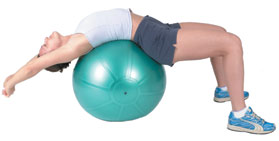If there is one piece of equipment you should try in your exercise program, it is the stability ball. Sometimes called an exercise ball or swiss ball, it is a large and inflatable ball used in place of an exercise bench. Despite being air-filled, it is generally heavy-duty and capable of supporting 600 to 700 pounds of weight. It is comfortable and gives good support.
One benefit of using the stability ball is it reduces the perception of working in training, especially for beginners- though it is equally beneficial for advanced exercisers. It gives some element of play as you are exercising.
You needn't be an expert in the gym to use an exercise ball and it is an ideal first piece of equipment in the home as it is very portable and light weight, easy to bring along even when traveling. It is also inexpensive compared to other exercise equipment and it will last for a very long time.

How Stability Balls Came About...
The use of stability balls originated in rehabilitation. As early as the 1900s, physical therapists have been using balls in addressing the neurological disorders of their patients.
Then, in the early 1960s, Aquilino Cosani, an Italian toy maker, made the ball and sold it, known then as the Gymnastik. Two decades later, Cosani established a company called Gymnic and became the major supplier of stability balls for rehabilitation programs and centers.
Because of the advantages, the use of the ball then shifted to the athletic area, in the 90s. It was used for conditioning of professional athletes and thereafter became very prominent in the fitness community.
At present medical specialists and fitness professionals, including me, very much recommend the use of the stability ball for use in your exercise program.
What Are the Benefits of Using a Stability Ball?
If you have regularly done crunches on the floor or a bench to develop you abdominal muscles, try ab exercises with a stability ball. You will quickly notice a difference in the way your abs react.
The exercise ball a great tool to improve the strength of the abs and the lower-back. Because it is a little unstable and you must constantly adjust to remain balanced, use of the stability ball improves the functional strength, balance and flexibility of the body. Using free weight with the ball as a bench is great for all those stabilizer muscles.
1. Proper Alignment
Using the ball during training will utilize many additional muscles to maintain stability and balance/ The dynamic movements during exercise will improve the natural motor reflexes of the body as different muscles are utilized in movement, especially the ones that are not usually used. The challenge posed by the ball is to maintain balance. As one aims to get the proper balance, the alignment of the body parts is also improved.
2. Great Abs
For people working out to achieve great abs, this ball can definitely target the abdominal areas. The abs and the back muscles are simultaneously worked.
3. Muscle Strength and Endurance
The stability ball can help in alleviating back pain and preventing pain in the future. As all the major muscle groups are exercised, tone, strength and endurance are improved. Flexibility and balance are improved.
4. Core Stability
The major muscles that helps stabilize and support all of your body movements are made up of the back and the deep abdominal muscles. With the ball, no matter how deep or into the core these muscles are, they are still exercised. This is something only the ball can guarantee.
5. Stretching
The ball is a good companion during stretching exercises. With this, you can easily move into and move out of different stretching positions.
6. Losing Weight
Any exercise that strengthens your muscles will help to reduce body fat. With regular exercise using the stability ball, weight loss is an added bonus.
You can find a great variety of Stability and Fitness Balls at good prices at Amazon.com
at good prices at Amazon.com
For more exercises using the exercise ball...click here.
Return to Personal Trainer Blog
Inspirations Personal Training Home Page:
Let Cindy be Your Personal Trainer




